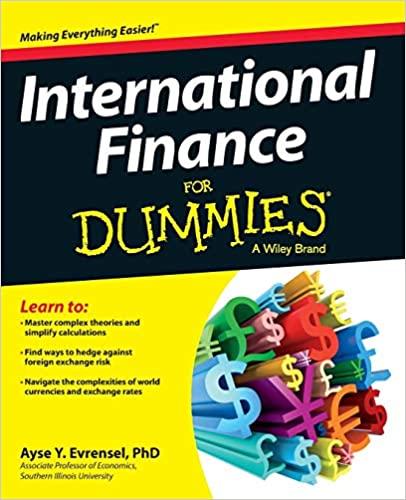Question
1 . You have $200 to invest. If you put the money into an account earning 4% interest compounded annually, how much money will you
1. You have $200 to invest. If you put the money into an account earning 4% interest compounded annually, how much money will you have in 10 years? How much money will you have in 10 years if the account pays 4% simple interest?
2. You have $1,300 to invest today at 5% interest compounded annually.
a.Find how much you will have accumulated in the account at the end of (1) 6
years, (2) 12 years, and (3) 18 years.
b.Use your findings in part a to calculate the amount of interest earned in (1) the first 6 years (years 1 to 6), (2) the second 6 years (years 7 to 12), and (3) the third 6 years (years 13 to 18).
c. Explain why the amount of interest earned increases in each succeeding 6-year period.
3. As part of your financial planning, you wish to purchase a new car 8 years from today. The car you wish to purchase costs $17,000 today, and your research indicates that its price will increase by 2% to 4% per year over the next 8 years.
a.Estimate the price of the car at the end of 8 years if inflation is (1) 2% per year and (2) 4% per year.
b.How much more expensive will the car be if the rate of inflation is 4% rather than 2%?
c.Estimate the price of the car if inflation is 2% for the next 2 years and 4% for 6 years after that.
4. Misty needs to have $12,000 in N=5 years to fulfill her goal of purchasing a small sailboat. She is willing to invest a lump sum today and leave the money untouched for 5 years until it grows to FV= $12,000, but she wonders what sort of investment return she will need to earn to reach her goal. Use your calculator or spreadsheet to figure out the approximate annually compounded rate of return needed if she can invest PV= $8,900 today.
5. a. How much money would you have to invest today to accumulate $5,000 after 5 years if the rate of return on your investment is 8%? Solve for Present Value.
b. What is the present value of $5,000 that you will receive after 5 years if the discount rate is 8%?
c. What is the most you would spend today for an investment that will pay $5,000 in 5 years if your opportunity cost is 8%?
6. An Iowa state savings bond can be converted to FV=$750 at maturity N=16 years from purchase. If the state bonds are to be competitive with U.S. savings bonds, which pay I/R= 9% annual interest (compounded annually), at what price must the state sell its bonds? Assume no cash payments on savings bonds prior to redemption. Ignore taxes. Solve for Present Value.
7. Gabrielle just won $3 million in the state lottery. She is given the option of receiving $1,100,000 now, or she can elect to receive $100,000 at the end of each of the next 30 years. If Gabrielle can earn 7% annually on her investments, which option should she take?
8. Hal Thomas, a 35-year-old college graduate, wishes to retire at age 60. To supplement other sources of retirement income, he can deposit $2,000 each year into a tax-deferred individual retirement arrangement (IRA). The IRA will earn a return of 15% over the next 25 years.
a.If Hal makes end-of-year $2,000 deposits into the IRA, how much will he have accumulated in 25 years when he turns 60?
b.If Hal decides to wait until age 45 to begin making end-of-year $2,000 deposits into the IRA, how much will he have accumulated when he retires 15 years later?
9. An insurance agent is trying to sell you an annuity, that will provide you with $5,100 at the end of each year for the next 35 years. If you don't purchase this annuity, you can invest your money and earn a return of 5%. What is the most you would pay for this annuity right now? Ignore taxes.
10. Rishi Singh has $1,200 to invest. His investment counselor suggests that Rishi should buy an investment that pays no interest but will be worth $1,500 after 7 years.
a. What average annual rate of return will Rishi earn with this investment? (round to two decimal places).
b. Rishi is considering another investment, of equal risk, that earns an annual return of 1.24%. Which investment should he make, and why?
Step by Step Solution
There are 3 Steps involved in it
Step: 1

Get Instant Access to Expert-Tailored Solutions
See step-by-step solutions with expert insights and AI powered tools for academic success
Step: 2

Step: 3

Ace Your Homework with AI
Get the answers you need in no time with our AI-driven, step-by-step assistance
Get Started


